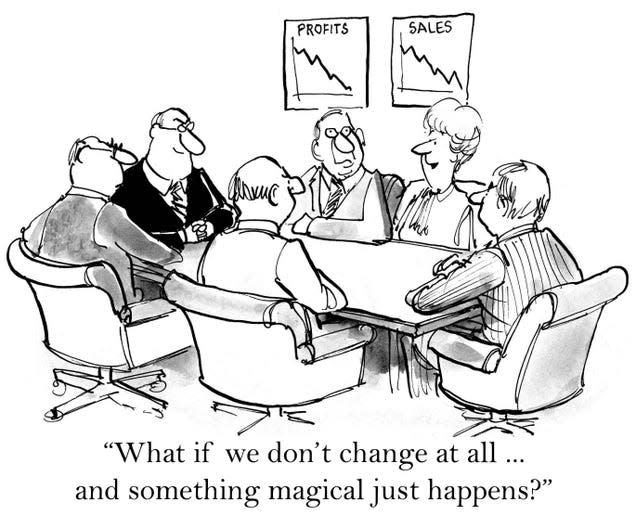7 questions to ensure transformation efforts continue during a recession

Kristen Groh is a senior partner at Prophet, specializing in digital transformation strategies and has also worked at Publicis Sapient, leading a portfolio of consumer products.
As global markets lurch toward recession, it’s easy for companies to slow or pause transformation or change initiatives. Yet history has repeatedly shown that challenging economies often spur innovation. It’s true for start-ups: Airbnb, Venmo, and Instagram all roared to life during the Great Recession. And it can be even more true for legacy companies, able to swagger into new markets backed with brand recognition and years of trust. In recessions, companies can pounce on new opportunities as competitors pull back.
Leaders must be confident enough to be curious to accelerate transformation in uncertain markets. They’ve got to ask the right questions and accept that last year’s roadmap may need recalibration.
Read more
Organizations should consider themselves a macrocosm of the individual, having a collective DNA, body, mind, and soul. That human-centered approach—recognizing that an organization’s culture needs to be understood as a holistic ecosystem—offers exceptionally useful guardrails for faltering transformations.
7 questions to audit transformation efforts during times of change
Here’s a seven-question diagnostic to help determine whether current transformation efforts still offer the best opportunity for exceptional growth and what is at risk if the company doesn’t transform.
1. How are customer behaviors, spending habits, lifestyles, and priorities shifting?
Start with the essence of what your company does. You exist to serve customers. And their needs and behaviors, already dramatically different from pre-pandemic times, are being reshaped by inflation and rising interest rates. Increasingly, permanent hybrid workplaces are also evolving. These fundamental shifts require re-assessing plans. Which segments of your customer base are hit hardest economically? How can you enrich the value of products and services to serve them better? What type of experience innovation would help them most?
2. How are competitors changing?
As other companies navigate through uncertainty, they’ll change tack. Are they pulling back, and might that create new growth opportunities that fall under your company’s north star? Do their shifts make the time right to divest non-core businesses? Are acquisition targets more appealing (and maybe better priced) than they were in the past? What can you learn from the adjustments they’re making?
3. Is there still a compelling business case, measurement, and governance model for the transformation strategy?
As many executives may have to focus on where and when to reduce costs and how to update their strategy, transformation leaders must be able to justify the plan’s financial impact. How will it help drive growth coming out of a recession? What are the competitive risks of failing to transform? What adjustments do you need to make in the approach to achieve results that will make an impact on updated company goals and targets?
4. What skills do you need to get where you want to be?
Empower your workforce with new skill sets and personal growth opportunities directly related to the transformation, making their role more relevant and connected. Focus on cross-training with technology, such as teaching search engine optimization to marketing teams or data analytics to claims adjustors. Those investments don’t just help the company—they inspire people. A study from IBM finds that employees are 42% more likely to stay (pdf) with a company when they receive training.
5. How can you collaborate more, encouraging cross-organizational innovation?
Cross-organizational collaboration is essential to fuel the creative, rapid solutions that uncertain markets call for. It allows leaders and teams to break down silos, building new value propositions.
Effective collaboration is a challenge for most companies during normal times. Yet Prophet’s research finds that the more organizations collaborate, the more they succeed. Employees see themselves as more productive. They value ways that collaboration helps them grow, personally and professionally. Even the most siloed companies can begin this effort, piloting small cross-functional teams with clear goals and publicly celebrating their efforts.
6. How are you encouraging risk?
Some companies visibly reward risk-takers, like P&G with its “heroic failure awards,” HubSpot with “failure forums,” or Tata with its “dare to try” awards. Role-model risk-taking. For those who have grown up in results-oriented organizations, it feels unfamiliar. But a human-centered approach requires focusing on process and behaviors, not just outcomes.
7. How are you managing morale?
Clear, consistent communication is the best tool to manage emotions and build morale. Honestly and transparently report on transformation progress. Acknowledge the people impacted by the change to help them feel part of it all. Taken together, this builds a culture of resiliency.
Answering these seven questions will require digging deep into your company’s mind, body, and soul. And it will also make sure that transformations stay relevant, guiding your organization toward successful change and uncommon growth.
More from Quartz
Sign up for Quartz's Newsletter. For the latest news, Facebook, Twitter and Instagram.

